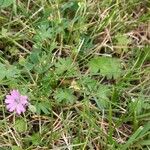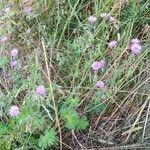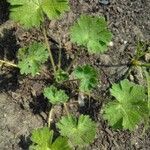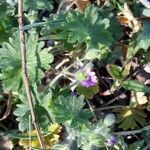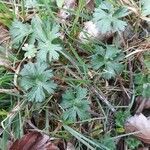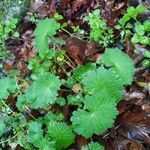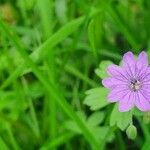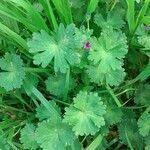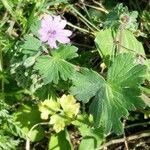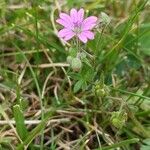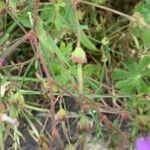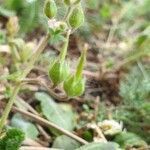Taprooted, annual herb, with basal rosette of lvs, densely covered in short or long hairs. Stems decumbent or ± ascending, pinkish, to c. 50 cm long. Petiole of rosette and lower cauline lvs to 14 cm long, densely covered in patent white hairs. Lamina palmately lobed, 1.5-5 × 1.5-6 cm, reniform to orbicular, densely covered in long white hairs; lobes 5-9, extending to c. 3/4 way to petiole, usually with 3 oblong to obovate, obtuse to rounded, secondary lobes towards apex. Upper lvs smaller and simpler with shorter petioles. Fls numerous, usually paired; peduncles with dense, long, white, eglandular and short glandular hairs; pedicels similar but often < peduncles and curving upwards after flowering. Sepals 2-3.5 mm long, ovate, with hairs as on pedicels, mucronate. Petals (3)-4-6 mm long, obovate, rosy pink or pink, deeply emarginate; claw very short. Filaments whitish; anthers mauve. Mericarps c. 1.5 mm long, broad, glabrous, with prominent pale transverse ridges. Seeds smooth.
Annual herb, stems up to ±4 long, decumbent or ascending, pilose with glandular and eglandular hairs. Stipules ovate, acute. Radical leaves tufted, petioles up to 250 mm long, pilose as the stem; blade up to 60 mm in diam., divided halfway or more to the centre into 5-9 lobes, lobes oblong-obovate, deeply 3-fid, both surfaces thinly pilose; cauline leaves similar but petioles progressively shorter and blade reduced. Peduncles opposite the upper reduced leaves eventually forming large compound cymes, usually 2-flowered, pilose with spreading hairs often gland-tipped. Pedicels similar to peduncles. Sepals ±2.5-4 x 1.5-2.5 mm, pilose. Petals ±3-7 x 2-3 mm, deeply notched, purplish-pink. Rostrum glandular-pubescent. Carpels transversely ridged, glabrous.
Annual herb, 0.05-0.45 m long; decumbent or ascending. Radicle leaves tufted; lamina up to 60 mm in diam.; 5-9-lobed halfway or more to the centre; lobes oblong-obovate, deeply 3-fid, both surfaces scarcely pilose; petioles up to 250 mm long, pilose; cauline leaves similar but petioles shorter and lamina reduced. Inflorescences opposite upper reduced leaves, compound cymes large, 2-flowered, pilose with spreading hairs, often gland-tipped; pedicels similar to peduncles. Sepals 2.5-4.0 x 1.5-2.5 mm, pilose. Petals 3-7 x 2-3 mm, deeply notched, purplish pink. Flowering time Dec.? Carpels glabrous, transversely ridged.
Spreading or ascending annual, branched from the base, 2–5 dm; basal lvs rotund or reniform, 2–5 cm wide, 5–9 cleft, the segments usually 3-lobed at the summit; upperlvs progressively reduced, the uppermost alternate; fls numerous; cal and pedicels densely glandular-puberulent and also hirsute; sep acute, 3–4 mm at anthesis; pet 5–7 mm, deeply notched; fr (including the cal) 9–13 mm, the stylar beak 2–5 mm, the carpel-bodies glabrous but usually with oblique, curved wrinkles; 2n=26. Native ofEurope and w. Asia, now widespread as a weed and found here and there in our range. Apr.–Sept.
A low spreading herb. It forms tufts and creeps over the ground. It is greyish green and an annual plant. The stems branch from the base. They are softly hairy. The leaves near the base are rounded or kidney shaped. They are divided into 5-7 wedge shaped 3 lobed segments. The upper leaves are more deeply divided. The flowers are pinkish-purple. They are 7-10 mm across. They are in loose clusters. The petals have deep notches.
